It’s the year that I turned 12 and the year that the internet was born, at least in a purely technical sense. The first mobile phone call was also made and there was a huge ‘video game crash’ which triggered the end of Atari and was partly caused by the rise in home computing (this is the same crash that, legendarily, saw thousands of ET game cartridges buried in a New Mexico desert). Ironically the first Nintendo console also went on sale this year. In less technical news, the final episode of M*A*S*H was aired in February, garnering a massive audience of 121 million. The space shuttle Challenger launched on its first mission in April and Michael Jackson debuted the Moonwalk at a Motown celebration, causing the audience to lose their shit. If you can think of any other year that more clearly paved the way for what would follow then: answers on a postcard.

If you were to delve into the deep, dark history of this blog you’d probably find a number of old reviews. Not so much in the last few years. While I am occasionally tempted to jot down my thoughts and feelings on the movies and TV shows I’ve watched or the books I’ve read I typically find, before the idea takes hold, that I’ve already moved onto the next thing. I have decided to preserve my train of thought long enough to make an exception for Alien: Earth however, simply because it’s a TV show based on Alien which means it’s of a certain personal significance and also because it, perhaps, tells an interesting story about pop culture media in the current day and age.
1982. I hit my eleventh year. This one always feels to me like the year that pop culture really started happening. In truth it had been on the boil for a while, but with E.T. dominating cinemas, Michael Jackon’s Thriller storming the charts, and the debut of the CD this was a year of huge tentpoles for consumers to latch onto (or to be fed with until they burst). Perhaps fittingly, the first emoticons (the humble smiley) made their appearance this year. Conversely, in another sign of the old guard falling away, ABBA made their final TV appearance.
In the UK the Falklands War kicked off. Naturally I remember this vividly, albeit through the lens of a politically innocent 11 year-old. It’s strange that, in its wake, I can’t think of a single film or TV series off the top of my head that uses the war as a backdrop (note that this doesn’t mean there weren’t any—there were plenty). Perhaps as wars go it was a particularly uninspiring one.
Overall, browsing through Wikipedia, 1982 looks like a very unsettled year—lots of plane crashes, lots of political unrest, Israel once again invading other territories (Lebanon this time) and various other fairly crap things going on. So let’s ignore all that and look at some movies!!
On August 1 1981 MTV aired its first video. That video was Video Killed The Radio Star, directed by Russell Mulcahy and featuring a youthful Hans Zimmer on keyboards. MTV would change the pop culture landscape, comfortably landing its bootprint in the realm of cinema along the way, and there could be no surer sign that the eighties were coming for our films than this video featuring two people who, in very different ways, would make their stamp on movies over the next decade and beyond.
Elsewhere in the world NASA finally launched its first space shuttle, Columbia, into space following a series of test flights. I vividly remember being at school and having a routine ‘medical’ but being able to watch the launch from the surgery. Talking of medical matters, the first case of HIV/AIDS was identified in the USA—the virus became a biological boogeyman which would haunt us throughout the eighties, would claim around 100,000 lives before the decade ended, and become a vicious political hot potato causing horrific antipathy towards gay people.
I turned 10 years old in 1981 (erroneously thinking this made me a teenager until my mother pointed out that I still had a few years to go) and was just starting to get a sense of myself. I would watch Top Of The Pops every week, and particularly enjoyed Adam And The Ants at the time, and was starting to get a clearer sense of where my film tastes lay too. The eighties were waiting, and so was I.
I turned nine in 1980 and was becoming a little more aware of movies, largely through sequels to movies I’d already enjoyed. That said, the hype surrounding The Empire Strikes Back was inescapable whether you were interested or not, and most other movies at the time I became aware of because of the posters everywhere. This was also a period of my life where I’d get taken to the USA for summer holidays (perks of having a parent in the travel business) which often meant I’d get to see movies months before they reached the UK—quite the privilege back then!
In terms of other events, 1980 was the year that Mount St. Helens erupted in Washington. I wasn’t there at the time, but I was in the area shortly afterwards and remember there still being ash everywhere. It was also, of course, the year that John Lennon was assassinated. The Beatles were before my time but the shock from Lennon’s murder resonated throughout the UK in a way that we wouldn’t see again until Princess Diana’s death. It’s curious to me that the seventies effectively began with the end of The Beatles and, ten years later, the eighties begins with the loss of one of the group’s major creative forces. With Elvis gone a few years earlier it’s almost as if the eighties was determined to shed the past and bring something new.
I’m taking a personal look back at the top ten films in every year since the one I was born in. We’re up to 1979. I was cannonballing towards 8 years of age. Margaret Thatcher took power in the UK, setting the political tone for the next few decades. The Ayotollah Khomenei was restored to power in Iran. Sony released the first Walkman, and Philips demonstrated the compact disc for the first time. Usenet was created by a couple of college students who were either very bored or very smart. Perhaps both. I might remember 1979 as a particularly drab year, but change was clearly afoot. And how was that reflected at the cinema, you ask? Let’s find out.
- Alien
- Nosferatu the Vampyre
- Apocalypse Now
- The Warriors
- Mad Max
- Stalker
- Escape from Alcatraz
- Moonraker
- Life of Brian
- Kramer vs Kramer
- Kramer vs. Kramer
- The Amityville Horror
- Rocky II
- Star Trek: The Motion Picture
- Apocalypse Now
- Alien
- 10
- The Jerk
- Moonraker
- The Muppet Movie
Only four movies appear in both lists this year, which again demonstrates how our tastes change in retrospect and when marketing hype is removed from the equation. To be honest the biggest surprise to me is seeing Moonraker in the IMDB top ten as I didn’t think anyone remembered that entry with great fondness. That said, the suspiciously high showing for Nosferatu does have me continuing to question the IMDB algorithm, Otherwise I think we have a pretty good spread of movies here, showing which titles had people queuing up at the box office in 1979, and which of those have stood the test of time.
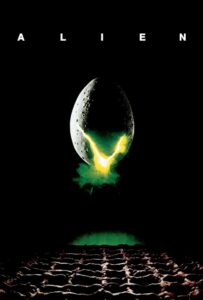
It might have started with the poster. Who could forget that haunting, enigmatic, almost indecipherable image. And the immortal tagline. An absolute masterpiece of movie poster design that conjures so many questions and delivers no answers. You look at it and you instantly want to know what the hell it means, while another part of you suggests you run; run very far away and never look back. All you know is that something is coming. Something is about to be birthed. And it’s probably going to be the worst thing you could possibly imagine.
I believe my first encounter with Alien was in the winter of 1979 (this would be following the September release date). I was in Kingston Upon Thames, shopping with my mother, and the local Odeon had posters all over declaring “Alien is here!” Clearly quite an event.
Whether I knew anything at all about the movie at that point I’m not sure, but one of my babysitters told me, with great delight, and in great detail, about the chestburster scene. It was like nothing that anyone had ever seen before in film, and it was certainly like nothing I’d ever heard before. I’m pretty sure I was into my monsters and science-fiction phase by then (as a growing Doctor Who fan, of course, those things run hand in hand) so it was the perfect scenario to capture my imagination (and my nightmares).
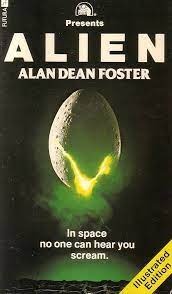
My next encounter with Alien happened in my local library whereI had taken it upon myself to offer my time to help out in the children’s section. One day, walking home from school, I had asked if they would let me work there and they said yes—and so, I would often stop by on my way home from school and help out for an hour or so. I used to love being around books and the process of taking a book, writing the due date on the lender’s card, filing the book’s reference card at the front desk, and handing it over … well, it seemed like a dazzling responsibility to an eight-year-old.
One day the novelization of Alien ended up behind the counter. I’m not sure if it was there by mistake, or if one of the other librarians was reading it. In any case I picked it up and started thumbing through it. I had no illusions about reading the whole thing (although I’m pretty sure I did read the chestburster scene) but it did come with eight pages of photographs. I flicked back and forth through these trying to put the story together. I ended up with something a bit like Forbidden Planet (in tone, at least) except the egg from the poster was the spaceship, the Nostromo, and the alien was about the size of a cat. In my head it remained this otherworldly, almost entirely unimaginable thing. Something that bore no relationship to live as we knew, or any experience that we could currently conceive of.
I couldn’t wait to see it for myself.
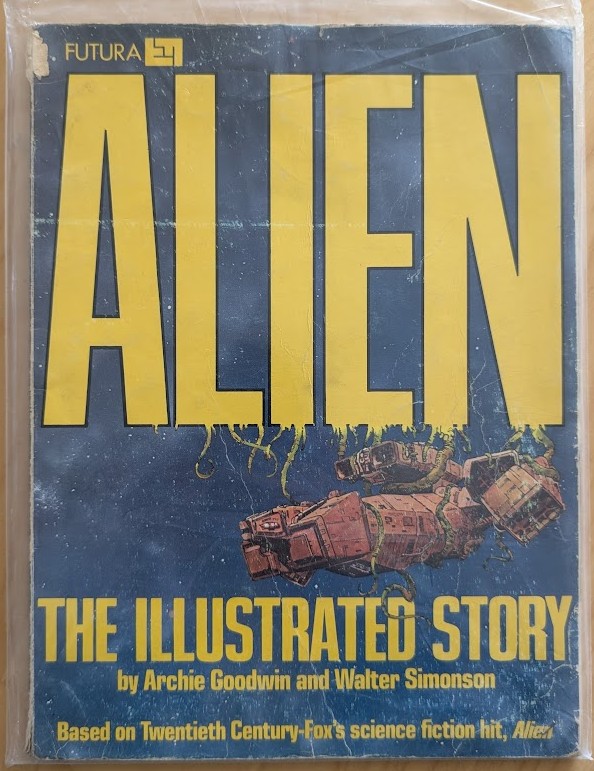
Another one of my delights growing up was bookstores. I would spend lots of my time browsing the shelves of our local bookstore (Langton’s) and at one point we also had a sort of pop-up discount bookstore turn up. I guess it was one of those outfits that sells off remaindered books. Anyway, the important thing is that they had the graphic novel of Alien (a great adaptation and well worth flicking through) which my mother allowed me to buy. I sat on the sofa that very night consuming the story and poring over every page. Naturally, as a barbaric pre-teen, it was the various death scenes that caught my attention the most. I studied every shot of the alien, even the design and layout of the panels. I got my first sense of story structure from that book, realising quite early on that it was arranged so there would be a death every two pages (once things got started). It was, inevitably, a different experience from the movie but it still gave me a sense of the cinematic scale and rendered the characters in brilliant shorthand.
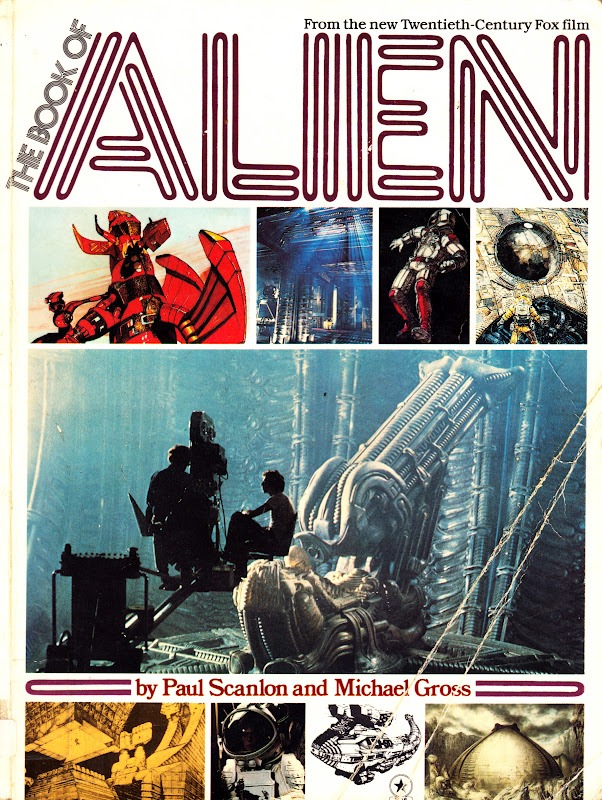
Two other books fuelled my obsession. One was called The Book of Alien. It’s the only one of these books that I somehow don’t have anymore, and it covered the making of the movie. Again I would pore over it, loving the production designs, fascinated by all of the options that never made it into the film. Most striking of all were the images delivered by H.R.Giger. I was familiar with how films were made, the trickery that went into special effects and stunts, but this might be the first time I had a sense of the visual development that goes into a film. I still hadn’t seen the movie at that point but I knew enough about it to be intrigued by the designs that didn’t make it into the movie, as well as the subtle differences between the alien in the movie and the one from Giger’s original paintings. I had the sense that what you can imagine and what you can actually put in your movie are quite different things, and part of the challenge is making them as seamless as possible.
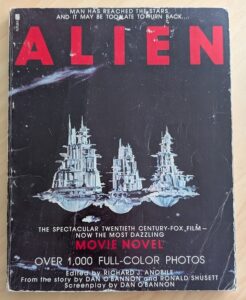
My closest contact with the film itself came through the photonovel—a format that almost became a thing in the late seventies (I remember smaller photonovels for The Wrath Of Khan and Invasion Of The Body Snatchers). The Alien photonovel was a deluxe A4 softbound book filled with glossy colour still images from the film, alongside snatches of text to provide the narrative. I recall not being able to afford it for quite some time and mostly enjoying it while lurking in Forbidden Planet. Eventually I did buy it—and I still have my copy to this day. I haven’t looked at it for many years, but at the time it was the closest equivalent I could get to owning the movie on home video. It was, essentially, my copy of the film.

There’s one other piece of Alien merchandise I still have from my youth; something my father brought back for me following a trip to the US. In 1979, buoyed with the success of Star Wars toys, Kenner decided to produce an 18” Alien figure. They somehow missed the message that Alien wasn’t a kids movie and parents were reportedly horrified when their kids unwrapped this biomechanical monstrosity. The toy was a failure, the stores started selling them off cheap, and my father grabbed one. And lugged it all the way back from the USA for me. Bear in mind the box was huge. It’s probably one of the most amazing gifts I’ve ever received. It’s so cool!
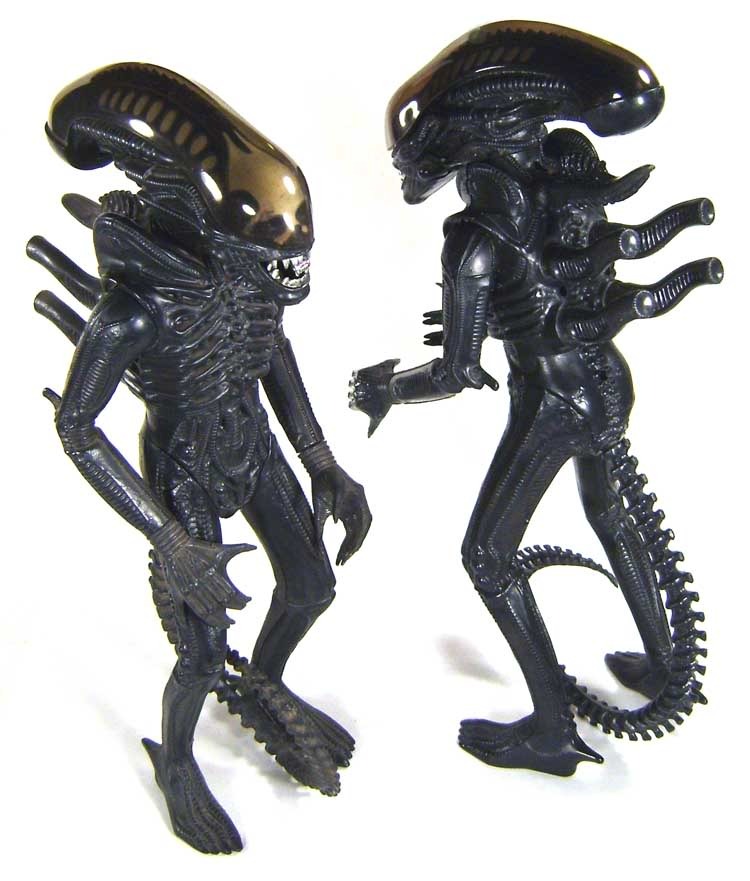
But what about the actual movie?
As those of who read my 1978 post will recall I had a near miss with Alien on home video in 1981. My chance to see it finally came a year later with its UK TV debut in July 1982. I remember literally falling off the sofa when I saw the trailer, recognising the movie right away. The irony? I was due to be away on holiday at the time, so I made my mother pledge to record it for me so we could watch it when I got back. I might have only been 11 but there was no way I was missing out on this, and it’s not like I didn’t already know every gory detail.
It fascinates me, looking back from this era of 4k Dolby Atmos home cinema, how I grew up watching movies in pan-and-scan, on super low quality VHS, and often with ad breaks (if the films were recorded off TV—which often meant various additional cuts and dubs too). Furthermore, the TVs weren’t nearly so big in those days either. We’re probably looking at around 25” (the size of the average PC monitor today). I’m sure the experience would horrify me now but I grew up watching films this way, and fell in love with some of my favourite films this way.
And so this was my first experience of Alien (and my ongoing experience of it for some time). I’ve watched it so many times now that all those viewing experiences have coalesced into one continuous thing. However, I vividly remember the tension from that first viewing. In particular, the scene where Brett is trying to find the cat (I laughed at him making cat noises, which hadn’t featured in any of the various books). I knew what was going to happen, of course, but sometimes the knowing just makes the build-up worse—and Ridley Scott paces that scene so well: shifting from an innocuous search for a cat, to a developing sense of unease, to an encounter with something unimaginable.
I watched that copy so many times that several of the ad break locations remain seared into my memory of the film (when Lambert resigns herself to being included on the expedition party; a calm moment where Jones grooms himself). There was at least one school holiday when I watched Alien every morning. That would be my routine: get out of bed, have breakfast, watch Alien. I simply didn’t get tired of it, and it was during those viewings that other aspects of the film—such as the music—began to jump out at me more and more. At some point I got the vinyl soundtrack and was baffled that it bore only a passing resemblance to the music I could hear in the film.
I’m going to guess that it wasn’t until 1989 that I replaced my TV copy (the first UK ‘sell-through’ release of Alien was February 9, 1989). Particularly exciting was a special widescreen release in 1992 (I still remember the weird brown hue of that cover)—remember, films were released in pan-and-scan as standard in those early days. More exciting yet was a “facehugger” box set arriving in 1993 that included all (at the time) three films in widescreen plus a bunch of extra features, including deleted scenes for Alien!

Those deleted scenes were a revelation to me—and not solely because some of them were the stuff of legend (remember, back you’d typically got the film and nothing else: the likelihood of seeing extra footage was a near impossibility). I watched them and came away with the feeling that they didn’t quite fit in with the film. The tone was a little off. I’m sure part of it was that I was so familiar with the film in its release state than anything else would seem, well … alien. It was more than that, though. There was an alternative version of Brett’s death included (by the way, these scenes are standard inclusions on every release these days, so if you have a copy go and check it out) and the curious part of it was that I recognised some shots from the final movie. It was one of the first times I learned what a huge role editing had played in the final film—choosing the preferred moments, and splicing them together. These deleted scenes weren’t just an illustration of how a few moments of the story had been chopped out for pacing; they were an insight into how the mood and tone of a film can be radically changed through editing. You only need to look at some of the behind the scenes footage showing the creature, and then compare with the final movie, to see this. (For the very best example of the power of editing check out “How Star Wars was saved in the edit“).
I could go on quite a bit about the home video history, but I did finally get to see Alien on the big screen thanks to a BFI screening at the National Film Theatre (I can’t recall when this happened, but I’m going to take a guess at the late 1990s). This was the first time I could be awed by the scale and spectacle of the movie—the space scenes just don’t come off on the small screen, and the influence that 2001 had on Ridley Scott here really comes through when you see the film properly. I was also fortunate to be invited to a screening of the director’s cut version when that came out (for the record I think I like both versions equally, though lately I’m leaning more towards the original theatrical cut).
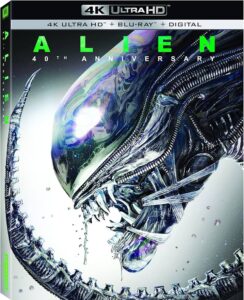
Skipping to the present and I have a big TV and a surround system that would have seemed like impossible dreams to me growing up. Alien was released on 4k back in 2019 (for the 40th anniversary) and naturally it was an essential purchase for me. The incredible thing is that, even after almost 40 years of watching the film, and countless viewings, the 4k showed me things I had never seen before. It really gave it a fresh experience. And by fresh I mean grimy—I had never realised before how damp the movie is, how much dirt and sweat there is, particularly towards the end.
We’ve had several ‘family’ viewings of the movie since and I’m delighted that both of my sons seem to appreciate the movie almost as much as I do. It’s funny to think about how we can now find out almost any detail about the movie on the internet, or through the dozens of books that have been published since. It’s such a gulf from where I came from, where films were mysterious and majestic, awe-inspiring creations.
And yet, none of that matters. A great film remains a great film, and that’s why we’re still talking about Alien today.
I’m doing a personal review of the top ten (more or less—usually more) movies from every year since the one I was born. This week … it was the year we all believed a man could fly. Or perhaps you didn’t. Perhaps you weren’t even born then? Meanwhile, these days we have movie characters flying off left right and centre. It must all seem so perfectly normal. Well, if either of those are you, come with me, grab your Superman crotch popcorn bucket and let’s take a walk through the past with a recap of the top movies of 1978.
- Grease
- Superman
- The Deer Hunter
- National Lampoon’s Animal House
- Death On The Nile
- Halloween
- Invasion Of The Body Snatchers
- Days Of Heaven
- Dawn Of The Dead
- Watership Down
- Grease
- Superman
- National Lampoon’s Animal House
- Every Which Way But Loose
- Heaven Can Wait
- Hooper
- Jaws 2
- Revenge Of the Pink Panther
- The Deer Hunter
- Halloween
Let’s kick off with a few changes to the format. Firstly, I’ve tweaked the IMDB listing to only show movies that have a certain number of ratings and are above a certain score. I’m still not sure how IMDB calculates ‘popularity’ but this modest filtering will hopefully prevent the Swedish Nympho Slaves scenario from happening in future.
Second: given this is a personal reflection I’ve also opted to shuffle the way I list the movies below to vaguely reflect how significant they are to me (previously the order was roughly aligned with the chart listings). It’s never going to be as straightforward as my favourite movie being at the top and my least favourite at the bottom. Movies can be important to me without necessarily being titles I’d watch again and again. Nevertheless, you can view my ordering as a vague indication of preference.
Anyway, let’s go!
For a large part of this year I’ve been working on a collection of Terminator-inspired short stories. if you’re wondering “why…?” then you can read my introduction for the collection below, or you can always just skip right ahead and download the ebook from a variety of online bookshops (for free) or grab the epub directly right here.
It was the year of Star Wars and The Sex Pistols—two pop culture phenonema that couldn’t be further apart which but had a lasting impact on film and music. It was a year that encapsulated escaping from things past and launching boldly into whatever was going to come next. Even NASA was playing the game, launching various test flights of its new, future-facing space shuttle. It was the year of the Queen’s silver jubilee and the UK went crazy for it; I remember street parties and celebrations. I remember my Mum dressing me up as a cavalier (cool costume!) and we went to Windsor for what I assume was the lighting of the bonfire at Snow Hill on June 6. It was also the year that I started going to see movies at the cinema.
And what was Hollywood up to …?
- Star Wars: Episode IV – A New Hope
- Close Encounters of the Third Kind
- The French Connection
- Saturday Night Fever
- The Spy Who Loved Me
- Swedish Nympho Slaves
- Slap Shot
- Eraserhead
- Looking For Mr Goodbar
- Smokey and the Bandit
- A Bridge Too Far
- Star Wars: Episode IV – A New Hope
- Smokey and the Bandit
- Close Encounters of the Third Kind
- Saturday Night Fever
- A Bridge Too Far
- The Deep
- The Spy Who Loved Me
- Oh, God!
- Annie Hall
- Semi-Tough
This marks the first year that I can finally access global box office stats. As such I won’t be using the North America box office top ten any more. While I expect the majority of the films that appear in the top ten will still be US-produced, I’m far more comfortable having a list that comes a little closer to reflecting what people around the world were paying to see at their local cinemas. However, there is also something a bit wrong in the IMDB top ten … which will be made plain if you inspect the number six entry up there. Given the ‘best films of the year’ is always going to be highly subjective, I think the IMDB list is as useful a barometer as any even if there’s something a bit skewiff with its algorithm. Either way, using both list allows me to see how the most popular contemporary films of the year relate to the most popular retrospective films of the same year.
